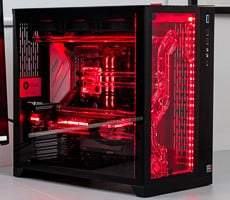Test Setup, PCMark 8 And Cinebench
How We Configured Our Test Systems: We configured other reference test systems in this article on an EVGA X79 Dark motherboard powered by an Intel Core i7-4960X six-core processor and 16GB of Corsair DDR3-1866 RAM. The first thing we did when configuring the test system was enter the system UEFI and set all values to their "high performance" default settings and disable any integrated peripherals that wouldn't be put to use. The memory's X.M.P. profile was enabled to ensure better-than-stock performance and the solid state drive was then formatted and Windows 8.1 Professional x64 was installed. When the installation was complete, we fully updated the OS and installed the latest DirectX redist along with all of the drivers, games, and benchmark tools necessary to complete our tests.
Dell's Alienware Area-51 was tested in an "as delivered" configuration, with the only modification being a quick update to the latest NVIDIA WHQL drivers for the GeForce GTX 980 graphics card. It was only in our overclocking test area that we modified any of the speeds and feeds of the system.
|
|
Gaming Tests Only - HH Test System: |
All Tests - Alienware Area-51: Intel Core i7-5930K (3.5GHz, Six-Core) Custom Dell Motherboard (Intel X99 Express) GeForce GTX 980 x 3 16GB Corsair DDR3-1866 Samsung SSD 850 Pro 256GB 4TB WD HDD Integrated Audio Integrated Network |
Relevant Software: Windows 8.1 Pro x64 DirectX April 2011 Redist AMD Catalyst v14.30.1005 B2 NVIDIA GeForce Drivers v344.07 Benchmarks Used: 3DMark "Fire Strike" Bioshock Infinite Hitman: Absolution Metro Last Light Sleeping Dogs Crysis 3 PCMark 8 Cinebench R11.5 FRAPS |
In a couple of CPU-centric, general purposes tests, we've compared the Area-51 to other reference gaming PCs from various system integrators. Again, these are relative metrics to offer watermarks of performance levels in specific applications. Since we have direct A/B comparison data in these test conditions, we opted to compare Alienware's new machine to these other high-end systems on the market.
|
PCMark 8 v2 is the latest version in Futuremark’s series of popular PC benchmarking tools. It is designed to test the performance of all types of systems, from tablets to desktops. PCMark 8 offers five separate benchmark tests--plus battery life testing—to help consumers find the devices that offers the perfect combination of efficiency and performance for their particular use case. This latest version of the suite improves the Home, Creative and Work benchmarks with new tests using popular open source applications for image processing, video editing and spreadsheets. A wide variety of workloads have also been added to the Work benchmark to better reflect the way PCs are used in enterprise environments.
These tests can be run with our without OpenCL acceleration. We chose to run with OpenCL acceleration enabled to leverage all of the platforms’ CPU and GPU compute resources.

|

The Alienware Area 51 takes second place overall in the Cinebench R15 CPU benchmarks. Although its powered by Intel's latest Haswell-E microarchitecture, the system's Core i7-5930K doesn't turbo high enough to catch the Haswell and Ivy Bridge-E based systems in the single-threaded test. In the multi-threaded test, the 5930K's six cores propel it up the charts, but its base / turbo clocks of 3.5GHz and 3.7GHz aren't high enough to catch the Core i7-4960X's 3.6GHz and 4.0GHz.






